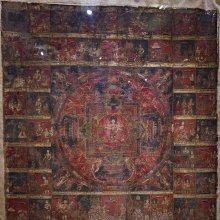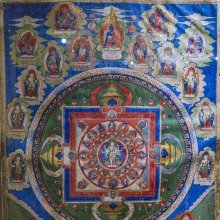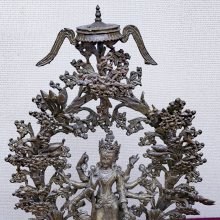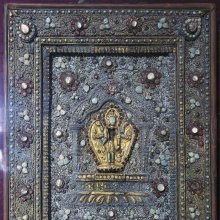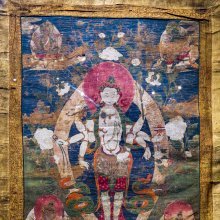Amoghapasha, Amoghapāśa, Amogha-pasha: 6 definitions
Introduction:
Amoghapasha means something in Buddhism, Pali, Hinduism, Sanskrit. If you want to know the exact meaning, history, etymology or English translation of this term then check out the descriptions on this page. Add your comment or reference to a book if you want to contribute to this summary article.
The Sanskrit term Amoghapāśa can be transliterated into English as Amoghapasa or Amoghapasha, using the IAST transliteration scheme (?).
Images (photo gallery)
(+8 more images available)
In Buddhism
Tibetan Buddhism (Vajrayana or tantric Buddhism)
Source: Wisdom Library: Tibetan BuddhismAmoghapāśa (अमोघपाश) is the name of Vidyārāja (i.e., “wisdom king”) mentioned as attending the teachings in the 6th century Mañjuśrīmūlakalpa: one of the largest Kriyā Tantras devoted to Mañjuśrī (the Bodhisattva of wisdom) representing an encyclopedia of knowledge primarily concerned with ritualistic elements in Buddhism. The teachings in this text originate from Mañjuśrī and were taught to and by Buddha Śākyamuni in the presence of a large audience (including Amoghapāśa).
Source: archive.org: The Indian Buddhist IconographyAmoghapāśa (अमोघपाश) or Amoghapāśalokeśvara refers to number 71 of the 108 forms of Avalokiteśvara found in the Machhandar Vahal (Kathmanu, Nepal). [Machhandar or Machandar is another name for for Matsyendra.].
Accordingly,—
“Amoghapāśa is four-faced and eight-armed and stands on a lotus. He carries in his four right hands the Vajra, the sword, the goad and the bow, while the four left carry the Ghaṇṭā, the Tridaṇḍī, the noose and the arrow”.
The names of the 108 deities [viz., Amoghapāśa] possbily originate from a Tantra included in the Kagyur which is named “the 108 names of Avalokiteshvara”, however it is not yet certain that this is the source for the Nepali descriptions. Tibetan Buddhism includes schools such as Nyingma, Kadampa, Kagyu and Gelug. Their primary canon of literature is divided in two broad categories: The Kangyur, which consists of Buddha’s words, and the Tengyur, which includes commentaries from various sources. Esotericism and tantra techniques (vajrayāna) are collected indepently.
Languages of India and abroad
Sanskrit dictionary
Source: DDSA: The practical Sanskrit-English dictionaryAmoghapāśa (अमोघपाश).—Name of a Lokeśvara (Buddhistic).
Derivable forms: amoghapāśaḥ (अमोघपाशः).
Amoghapāśa is a Sanskrit compound consisting of the terms amogha and pāśa (पाश).
Source: Cologne Digital Sanskrit Dictionaries: Monier-Williams Sanskrit-English DictionaryAmoghapāśa (अमोघपाश):—[=a-mogha-pāśa] [from a-mogha] m. Name of a Lokeśvara, [Buddhist literature]
[Sanskrit to German]
Sanskrit, also spelled संस्कृतम् (saṃskṛtam), is an ancient language of India commonly seen as the grandmother of the Indo-European language family (even English!). Closely allied with Prakrit and Pali, Sanskrit is more exhaustive in both grammar and terms and has the most extensive collection of literature in the world, greatly surpassing its sister-languages Greek and Latin.
See also (Relevant definitions)
Partial matches: Pasha, Amogha, Paca.
Starts with: Amoghapashalokeshvara.
Full-text: Bila, Bilapravesha, Vanavidhi, Amoghaguna, Vanapravesha, Vanavidhisadhana, Sagara, Amogha, Gunasagara, Shilashanta, Amoghapashalokeshvara, Devadevata.
Relevant text
Search found 6 books and stories containing Amoghapasha, Amoghapāśa, Amogha-pasha, Amogha-pāśa, Amoghapasa, Amogha-pasa; (plurals include: Amoghapashas, Amoghapāśas, pashas, pāśas, Amoghapasas, pasas). You can also click to the full overview containing English textual excerpts. Below are direct links for the most relevant articles:
The Indian Buddhist Iconography (by Benoytosh Bhattachacharyya)
108 forms of Avalokiteśvara (71): Amoghapāśa Lokeśvara
Diaspora of Bhuta (Daiva) worshipping cult—India and Indonesia (by Shilpa V. Sonawane)
Part 8 - Balinese Religion < [Chapter 4 - Inter-Disciplinary Analysis]
Lord Hayagriva in Sanskrit Literature (by Anindita Adhikari)
Hayagrīva in Buddhism < [Chapter 6]
The gods of northern Buddhism (by Alice Getty)
Chapter VI - The Principal Forms Of Avalokitesvara
Chapter X - Feminine Divinities
Tibetan tales (derived from Indian sources) (by W. R. S. Ralston)
A Dictionary Of Chinese Buddhist Terms (by William Edward Soothill)
Related products
